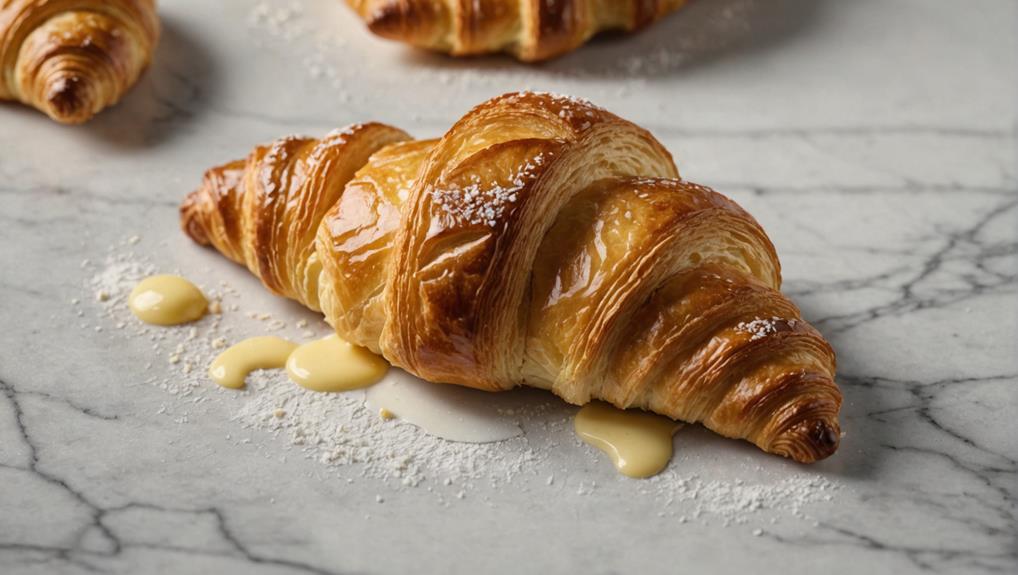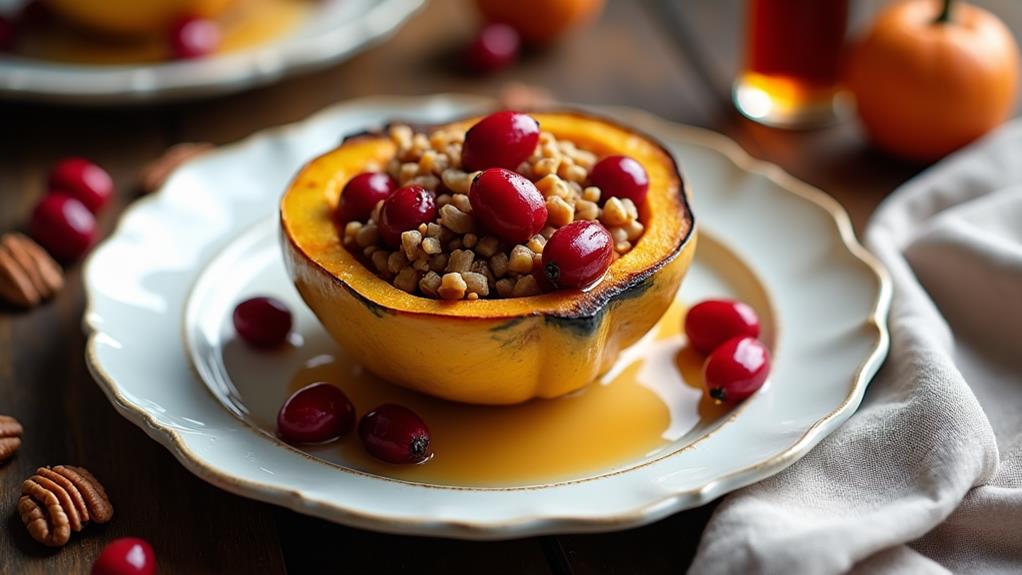To master the art of croissant perfection, you'll need to follow seven key steps. Start by gathering high-quality ingredients, including European butter and high-protein flour. Mix your dough carefully, ensuring proper gluten development. Master the lamination technique, creating multiple butter layers for that signature flakiness. Shape your croissants with precision, rolling them into perfect crescents. Proof your pastries in an optimal environment to achieve the ideal rise. Bake them to a golden-brown finish, monitoring closely for perfection. Finally, savor your flaky creation, enjoying the fruits of your labor. By following these steps, you'll unlock the secrets to croissant mastery.
Gather Your Ingredients
Before you embark on your croissant-making journey, gather all the essential ingredients.
You'll need 250g of high-protein bakers flour, which forms the foundation of your dough and ensures that perfect flaky texture you're aiming for.
Next, procure 100g of unsalted European butter with a fat content between 84-87%. This high-quality butter is crucial for achieving rich flavor and optimal texture in your croissants.
Don't forget to include 30g of sugar, which not only balances the flavor but also enhances the browning process during baking.
For leavening, you'll need 5g of fresh yeast. Make sure it's active to guarantee proper rise and that coveted airy texture in your final product.
Lastly, prepare 150ml of lukewarm milk to hydrate your dough, creating a soft and pliable base for those beautiful laminated layers.
Mix the Perfect Dough
To mix the perfect croissant dough, you'll need to start with high-protein bread flour, which provides the necessary structure for those coveted flaky layers.
Next, prepare your yeast and sponge, carefully combining the fresh yeast with lukewarm milk and sugar to activate it properly.
Choose High-Protein Bread Flour
The foundation of perfect croissants lies in selecting the right flour. To achieve those coveted flaky layers and ideal texture, you'll need to choose a high-protein bread flour with 12-14% protein content. This elevated protein level is crucial for developing the gluten structure that pastry chefs rely on for creating irresistible croissants.
When selecting your flour, opt for a bakers flour specifically designed for pastry. It outperforms all-purpose flour due to its higher protein content, which is essential for:
- Developing a strong dough that can hold layers of butter
- Enhancing the dough's elasticity when mixed with lukewarm milk
- Activating the yeast effectively for proper rise
Ensure your flour is fresh and properly stored to avoid any negative impacts on texture and rise during baking.
By using high-protein bread flour, you're setting the stage for croissant perfection. Remember, the right flour is your secret weapon in creating those iconic, buttery layers that define a truly exceptional croissant.
Don't settle for less – invest in quality flour and watch your croissants transform into bakery-worthy masterpieces.
Prepare Yeast and Sponge
Now that you've chosen the ideal flour, it's time to mix your perfect croissant dough. Begin by preparing the yeast mixture, combining 150ml of lukewarm milk with 5g of fresh yeast. Allow this to froth for about 10 minutes, ensuring the yeast is active and ready to work its magic.
While waiting, create a balanced dry mixture by combining 250g of high-protein bakers flour, 30g of sugar, and a pinch of salt in a separate bowl. This blend enhances flavor and controls yeast activity, setting the stage for exceptional croissants.
Once your yeast is frothy, gradually incorporate it into the dry ingredients. Mix until a rough dough forms, which is crucial for proper gluten development.
Next, knead the dough until it becomes smooth and elastic, creating a strong gluten structure that will support those coveted flaky layers.
Finally, let the dough rest in a cool place for 10 hours. This extended fermentation period is essential for developing complex flavors and improving the dough's structure.
With these steps, you're well on your way to creating the perfect croissant dough that will yield irresistibly buttery and flaky pastries.
Combine Remaining Ingredients Carefully
Precision is key when combining the remaining ingredients for your croissant dough. Start by gathering your high-protein bakers flour, unsalted butter, sugar, and salt.
Ensure your butter is softened but not melted; it should be pliable enough to incorporate without losing its structure, crucial for maintaining those coveted flaky layers. This technique is similar to achieving the perfect balance in a dish like Butternut Squash Mac and Cheese, where mixing the right components enhances both flavor and nutrition.
Now, it's time to innovate your dough-making process:
- Gradually mix in the prepared sponge to create a cohesive dough
- Knead for about 10 minutes until smooth and elastic
- Allow the dough to rest in a cool place for at least 10 hours
As you combine these ingredients, remember that each step contributes to the final texture and flavor of your croissants. The flour provides structure, while the butter creates those irresistible layers.
Sugar and salt enhance flavor and control yeast activity. Knead the dough thoroughly to develop the gluten, which is essential for achieving the perfect texture.
Once you've reached the desired consistency, let your dough rest. This prolonged cooling period is crucial for relaxation and flavor development, setting the stage for the upcoming lamination process.
Master the Lamination Technique
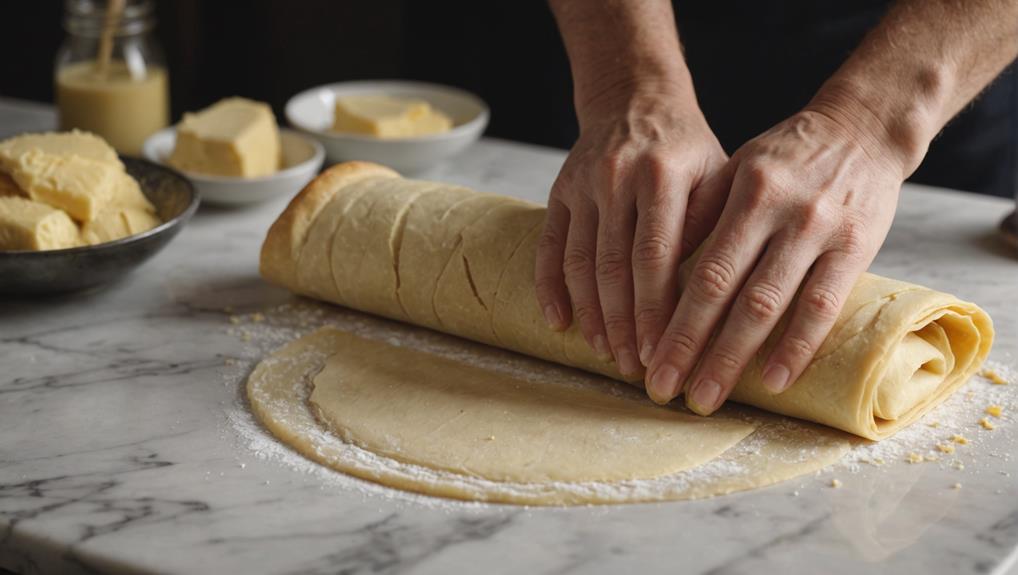
At the heart of croissant-making lies the lamination technique, a process crucial for achieving those coveted flaky layers. To master this technique, you'll need to carefully encase a solid block of butter within your dough. As you roll and fold the dough, you're creating a multitude of thin layers that will give your croissants their signature texture.
Start by ensuring your butter and dough are at similar temperatures. This prevents the butter from melting and compromising the layers. Use butter with a fat content of 84-87% for optimal results.
When you're ready to make croissants, begin the rolling and folding process. Each fold exponentially increases the number of layers, with the tri-fold method potentially creating up to 109 distinct layers. After each fold, chill the dough to relax the gluten and maintain layer integrity.
This resting period is essential for achieving the perfect flaky texture. Remember, the lamination technique is an art that requires patience and precision. By mastering this process, you'll unlock the secret to creating croissants with an irresistibly crisp exterior and a delightfully airy interior.
Shape With Precision
Shaping croissants with precision is crucial for achieving the perfect texture and appearance. Start by cutting your laminated dough into triangles, typically 10×15 cm, ensuring a wider base for optimal rolling.
As you shape with precision, remember these key steps:
- Roll the dough from the base to the point, applying gentle pressure to maintain the integrity of those precious butter layers.
- Tuck the points underneath to create the classic crescent shape, preventing unrolling during proofing and baking.
- Space the shaped croissants on your baking tray to allow for expansion.
Your technique will directly impact the final product's flaky texture and visual appeal.
As you roll the dough, avoid stretching, which can lead to uneven baking. Instead, focus on maintaining consistent pressure to preserve the lamination you've worked so hard to achieve.
Once shaped, allow your croissants to proof until they've doubled in size and jiggle slightly when touched. This proofing stage is critical for developing the airy, flaky texture that defines a perfect croissant.
With practice, you'll master the art of shaping, bringing you one step closer to croissant perfection.
Proof for Optimal Rise
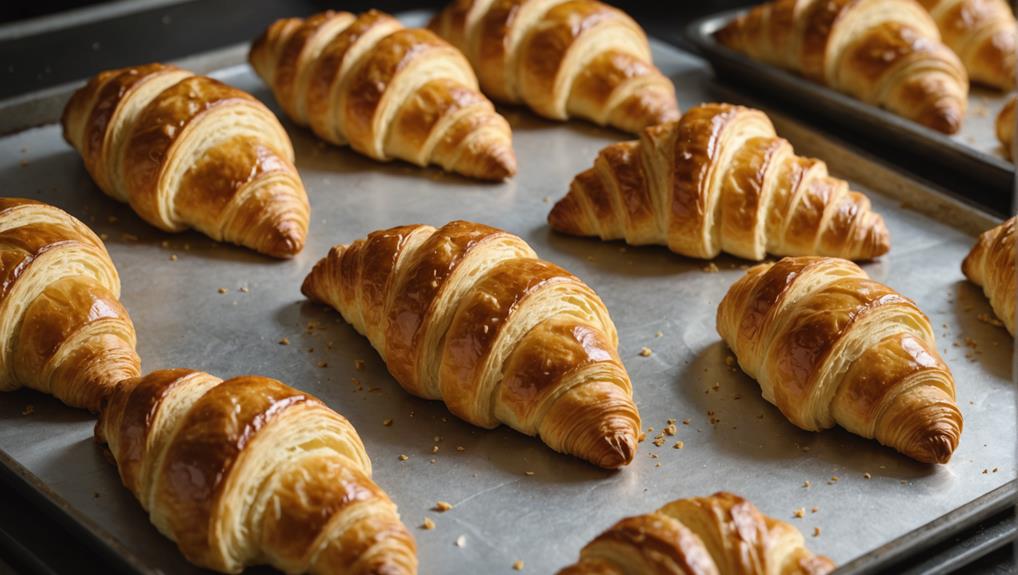
Proofing is the crucial final step before baking that can make or break your croissants. It's where the magic happens, transforming your carefully layered dough into a light, airy structure that'll yield the flaky pastry you're after.
To achieve optimal fermentation, you'll need to create the perfect environment for your croissants to rise. Set up a makeshift proofing box by placing a bowl of hot water in your oven. This innovative approach maintains the ideal temperature of 85°F and 80% humidity, preventing your delicate layers of dough from drying out.
Let your shaped croissants proof for 1.5 to 2 hours, or until they've doubled in size and jiggle gently when touched. You'll know they're ready when they feel soft and pillowy.
Don't rush this process – proper proofing is essential for developing those coveted flaky layers. As the yeast works its magic, producing carbon dioxide, your croissants will expand and create the perfect texture.
Bake to Golden Perfection
With your croissants beautifully proofed, it's time to transform them into golden masterpieces. Preheat your oven to 220°C (428°F) to ensure even cooking and optimal browning. Before baking, apply a generous egg wash to achieve that coveted shiny, golden-brown crust that'll make your croissants irresistible.
To bake to golden perfection, follow these key steps:
- Place croissants on perforated baking sheets for improved air circulation
- Bake for approximately 15 minutes, monitoring closely to avoid burning
- Allow croissants to cool on a wire rack post-baking for enhanced texture
As you embark on this final stage, remember that uniform baking results are crucial for achieving the perfect flaky, buttery croissant. The perforated baking sheets will prevent overly dark bottoms, contributing to an even golden color throughout.
Keep a watchful eye on your croissants as they bake, ensuring they reach that deep golden hue without crossing into burnt territory. Once out of the oven, resist the temptation to dig in immediately. Cooling on a wire rack is essential for maintaining the ideal airy structure and enhancing flavor.
Savor Your Flaky Creation
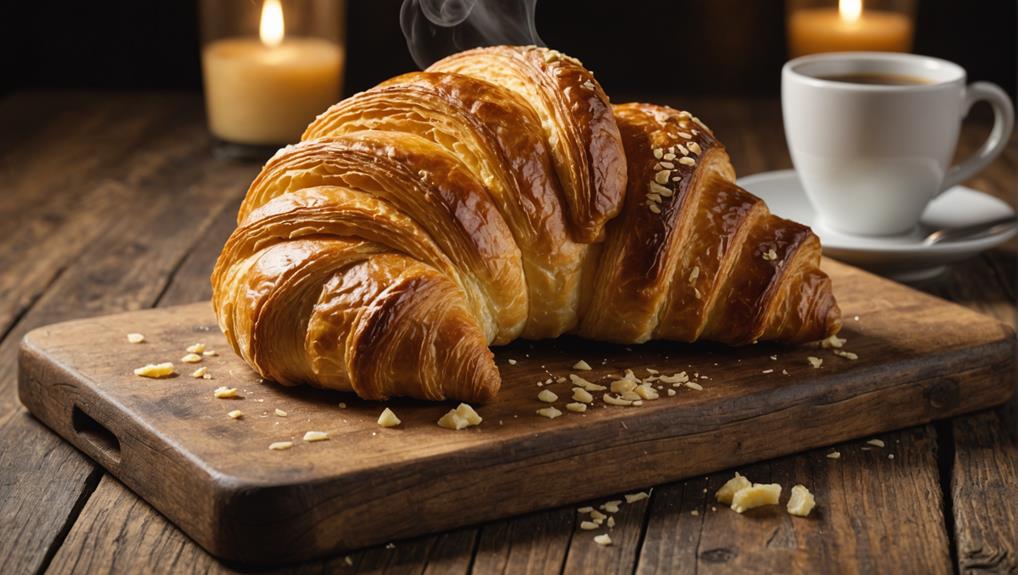
Savor Your Flaky Creation
After all your hard work, it's time to savor your flaky creation. Allow your freshly baked croissants to cool on a wire rack for at least 10 minutes, enhancing their texture and flavor development. This brief pause will reward you with the perfect balance of crispy exterior and buttery interior.
To complement your croissants, consider serving them alongside a simple, homemade BBQ Pulled Pork Sandwich, which pairs wonderfully with their delicate layers for a rich culinary experience.
To fully appreciate your croissants' delicate layers, consume them within 24 hours of baking. Pair these golden treasures with high-quality accompaniments that complement their rich flavor profile. Consider artisanal jams, local honeys, or carefully selected cheeses to elevate your culinary experience without overwhelming the croissant's subtle notes.
If you find yourself with leftovers, proper storage is key. Keep your croissants in an airtight container at room temperature for up to two days. For longer preservation, wrap them securely and freeze.
When you're ready to indulge again, reheat your croissants in a preheated 350°F oven for 5-7 minutes. This simple step will restore their crispy exterior, allowing you to relive the magic of your freshly baked creation.
Frequently Asked Questions
What Is the Secret of the Croissant?
You'll unlock the croissant's secret by mastering its history, selecting premium butter types, perfecting dough hydration, and honing fermentation processes. Innovate with cutting-edge baking techniques and experiment with unique filling options to elevate your croissant game.
What Are the Steps in Croissant Lamination?
Like a sculptor molding clay, you'll master croissant lamination. Start with dough resting, then embrace butter folding and temperature control. Execute precise shaping techniques, and finally, apply baking tips for innovative, flaky perfection. It's an art of patience and precision.
How to Master the Croissant?
To master croissants, you'll need to dive into their rich history, perfect dough fermentation, and explore diverse flavor profiles. Master baking techniques, fine-tune ingredient ratios, and experiment with innovative serving suggestions. It's a journey of continuous learning and refinement.
What Makes a Croissant Flaky?
You'll achieve flaky croissants by mastering dough lamination, controlling butter temperature, and perfecting yeast activation. Optimize ingredient ratios and employ innovative baking techniques to create hundreds of delicate layers that puff up during baking, resulting in irresistible flakiness.
Final Thoughts
You've mastered the art of croissant-making, a skill that's revered in the culinary world. Did you know that the average French person consumes 21 kilograms of bread annually, with croissants being a significant portion? As you savor your flaky creation, remember that practice makes perfect. Don't be discouraged if your first attempts aren't picture-perfect; even professional bakers spend years honing their technique. Keep experimenting, and soon you'll be crafting croissants that rival those from Parisian bakeries.

